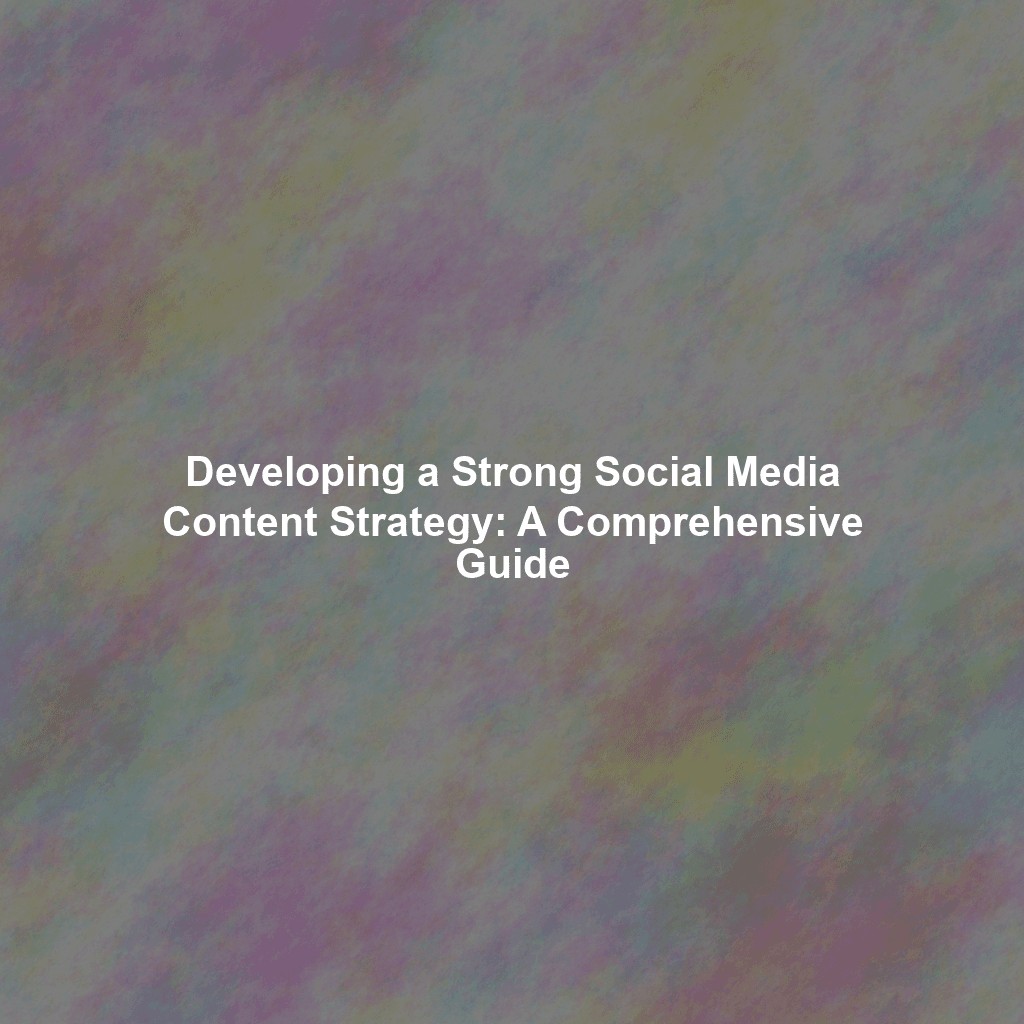In today’s digital landscape, a strong social media presence isn’t just a nice-to-have; it’s a necessity for businesses of all sizes. But simply posting content without a clear strategy is like throwing darts in the dark – you might hit something, but you’re unlikely to achieve your desired outcome. This guide provides a comprehensive, step-by-step approach to developing a robust and effective social media content strategy that aligns with your overall business goals.
Step 1: Define Your Goals and Objectives
Before you even think about content, you need to understand why you’re using social media. What do you want to achieve? Be specific and measurable.
Key Questions to Ask:
- What are your overall business goals? (e.g., increase sales, generate leads, improve brand awareness)
- How can social media contribute to achieving these goals?
- What specific metrics will you use to measure success? (e.g., website traffic, lead generation, engagement rate, follower growth)
- Are your goals SMART (Specific, Measurable, Achievable, Relevant, Time-bound)?
For example, instead of saying “increase brand awareness,” a SMART goal would be “Increase brand mentions on Twitter by 20% in the next quarter.”
Step 2: Understand Your Audience
Knowing your audience is paramount. You can’t create content that resonates if you don’t know who you’re talking to. This involves more than just knowing demographics; you need to understand their interests, pain points, and online behavior.
Key Activities:
- Develop Buyer Personas: Create detailed profiles of your ideal customers. Include demographics, psychographics, goals, challenges, and preferred social media platforms.
- Conduct Audience Research: Use social media analytics tools to gather insights about your existing audience. Look at demographics, interests, and engagement patterns.
- Analyze Competitor Audiences: See who’s following your competitors and what content they’re engaging with.
- Engage Directly with Your Audience: Ask questions, run polls, and encourage feedback.
Understanding your audience allows you to tailor your content to their specific needs and preferences, increasing engagement and driving results.
Step 3: Choose the Right Platforms
Not all social media platforms are created equal. Where you spend your time and resources should depend on where your target audience is most active.
Platform Considerations:
- Facebook: Broad audience, good for building community and sharing diverse content formats.
- Instagram: Visual platform, ideal for showcasing products, behind-the-scenes content, and influencer marketing.
- Twitter: Real-time updates, news, and engaging in conversations.
- LinkedIn: Professional networking, B2B marketing, and thought leadership.
- TikTok: Short-form video content, appealing to a younger audience.
- YouTube: Long-form video content, tutorials, and product demonstrations.
Focus on the platforms where your target audience spends the most time and where you can effectively achieve your goals. It’s better to master a few platforms than to spread yourself too thin across many.
Step 4: Content Planning and Creation
This is where the magic happens! Now that you understand your goals, audience, and platforms, you can start planning and creating compelling content.
Key Elements:
- Develop a Content Calendar: Plan your content in advance to ensure consistency and variety. Include topics, formats, publishing dates, and responsible team members.
- Brainstorm Content Ideas: Consider different content formats, such as blog posts, images, videos, infographics, live streams, and stories.
- Curate Relevant Content: Share content from other sources that your audience will find valuable.
- Create High-Quality Content: Focus on providing value, solving problems, and engaging your audience. Ensure your content is well-written, visually appealing, and optimized for each platform.
- Repurpose Content: Maximize the impact of your content by repurposing it for different platforms and formats. For example, turn a blog post into a series of social media updates or a video.
Remember to maintain a consistent brand voice and tone across all your social media channels.
Step 5: Scheduling and Publishing
Consistency is key to success on social media. Use scheduling tools to plan and automate your posts.
Popular Scheduling Tools:
- Hootsuite
- Buffer
- Sprout Social
- Later (for Instagram)
Experiment with different posting times to see what works best for your audience. Consider factors like time zones and when your audience is most active.
Step 6: Engagement and Community Building
Social media is a two-way street. Don’t just broadcast your message; actively engage with your audience.
Strategies for Engagement:
- Respond to Comments and Messages: Promptly answer questions, address concerns, and show that you value your audience’s input.
- Participate in Relevant Conversations: Join industry discussions and share your expertise.
- Run Contests and Giveaways: Encourage engagement and build excitement around your brand.
- Ask Questions: Start conversations and encourage your audience to share their thoughts and opinions.
- Use Hashtags Strategically: Increase the visibility of your content by using relevant hashtags.
Building a strong community around your brand can lead to increased loyalty, advocacy, and ultimately, business growth.
Step 7: Monitoring and Analysis
Social media is a constantly evolving landscape. You need to regularly monitor your performance and adjust your strategy accordingly.
Key Metrics to Track:
- Reach: The number of unique users who saw your content.
- Engagement: Likes, comments, shares, and clicks.
- Website Traffic: How many visitors are coming to your website from social media.
- Lead Generation: The number of leads generated from social media.
- Conversion Rate: The percentage of leads who become customers.
- Sentiment Analysis: The overall tone of conversations about your brand.
Use social media analytics tools to track these metrics and identify what’s working and what’s not. Don’t be afraid to experiment and make changes to your strategy based on your findings.
Conclusion
Developing a strong social media content strategy is an ongoing process. By following these steps, you can create a roadmap for success that aligns with your business goals, engages your target audience, and ultimately drives results. Remember to stay flexible, adapt to changes, and always focus on providing value to your audience.
 Skip to content
Skip to content

